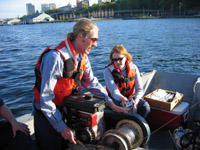 |
|||
| |TESC 431 Home| |Intro| |Methods| |Results & Discussion| | |||
22 April 2005, UWT students went out on the City of Tacoma's 21' Almar Baywatch with Captain Rick Fuller. The day was divided into distinct sections, one portion inside the lab and the other portion in the City of Tacoma boat collecting CTD data and water, sediment, and nutrient samples. In the morning session of our lab, one group counted plankton and zooplankton that was collected 21 April at 20:45 at Old Town Dock. Two samples were collected at that site; one a surface tow using a 20 micron size net and the other sample taken at one meter using the Niskin bottle. In the lab, the 1ml Sedgwick Rafter counting cell was used to count and classify the zooplankton and the .1ml Palmer counting cell was used to count phytoplankton. At all collection sites, samples were taken for analysis of dissolved oxygen, chlorophyll-a, and nutrients by using the Niskin bottle at the surface and also by using a Niskin bottle attached one meter above the CTD unit. CTD profiles for temperature, salinity, density, dissolved oxygen, fluorescence, and transmission were also collected. Analysis of samples for dissolved oxygen were completed that evening in the lab using the Winkler automated titration procedure and standard methods were used for chlorophyll-a analysis. The nutrient samples were to be sent to the University of Washington Seattle Marine Chemistry Lab for assessment and sediment samples taken from the Puyallup River Mouth (station #7) and at Mid Channel (station #2) were dried and tested at a later date for grain size analysis. Also, visibility was measured using the Secchi disc at each site. Only one zooplankton sample was taken during the day by using a 73 micron Puget Sound closing plankton net at station #4, Center (also known as the Department of Ecology data collection station CMB003). The sample was taken between the depths of 120m-70m and three sample bottles were filled with the sample. Some visible zooplankton was noted. Also a surface phytoplankton sample was taken at station #4. For more information on the basic collection and analysis methods, click here: Methods |
|||